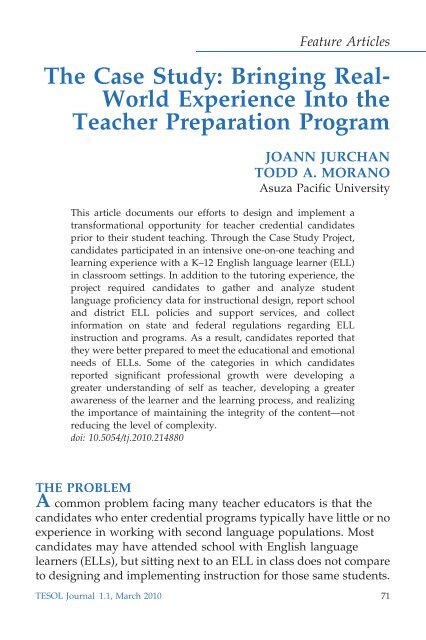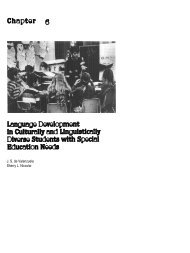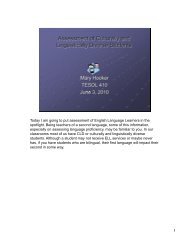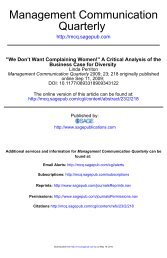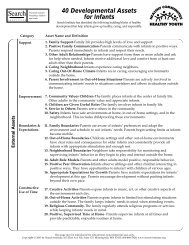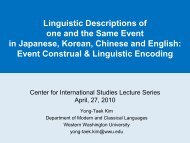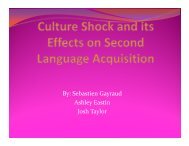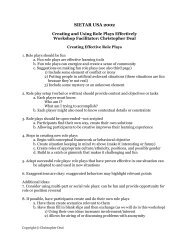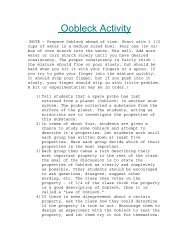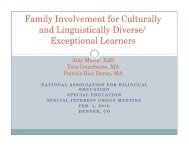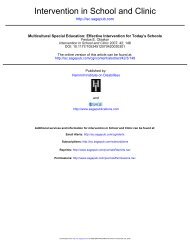The Case Study: Bringing Real- World Experience Into the Teacher ...
The Case Study: Bringing Real- World Experience Into the Teacher ...
The Case Study: Bringing Real- World Experience Into the Teacher ...
- No tags were found...
Create successful ePaper yourself
Turn your PDF publications into a flip-book with our unique Google optimized e-Paper software.
Feature Articles<strong>The</strong> <strong>Case</strong> <strong>Study</strong>: <strong>Bringing</strong> <strong>Real</strong>-<strong>World</strong> <strong>Experience</strong> <strong>Into</strong> <strong>the</strong><strong>Teacher</strong> Preparation ProgramJOANN JURCHANTODD A. MORANOAsuza Pacific UniversityThis article documents our efforts to design and implement atransformational opportunity for teacher credential candidatesprior to <strong>the</strong>ir student teaching. Through <strong>the</strong> <strong>Case</strong> <strong>Study</strong> Project,candidates participated in an intensive one-on-one teaching andlearning experience with a K–12 English language learner (ELL)in classroom settings. In addition to <strong>the</strong> tutoring experience, <strong>the</strong>project required candidates to ga<strong>the</strong>r and analyze studentlanguage proficiency data for instructional design, report schooland district ELL policies and support services, and collectinformation on state and federal regulations regarding ELLinstruction and programs. As a result, candidates reported that<strong>the</strong>y were better prepared to meet <strong>the</strong> educational and emotionalneeds of ELLs. Some of <strong>the</strong> categories in which candidatesreported significant professional growth were developing agreater understanding of self as teacher, developing a greaterawareness of <strong>the</strong> learner and <strong>the</strong> learning process, and realizing<strong>the</strong> importance of maintaining <strong>the</strong> integrity of <strong>the</strong> content—notreducing <strong>the</strong> level of complexity.doi: 10.5054/tj.2010.214880THE PROBLEMA common problem facing many teacher educators is that <strong>the</strong>candidates who enter credential programs typically have little or noexperience in working with second language populations. Mostcandidates may have attended school with English languagelearners (ELLs), but sitting next to an ELL in class does not compareto designing and implementing instruction for those same students.TESOL Journal 1.1, March 2010 71
Additionally, a common misconception shared by teachercandidates is that a smattering of one language, such as Spanish,will suffice to meet <strong>the</strong> totality of <strong>the</strong>ir instructional challenges withsecond language learners. Rarely do candidates consider <strong>the</strong> realitythat <strong>the</strong>y will in all likelihood have students from a variety ofprimary language backgrounds in <strong>the</strong>ir classrooms. Fur<strong>the</strong>rmore,<strong>the</strong> needs of <strong>the</strong> ELLs <strong>the</strong>y will teach extend beyond conversationalEnglish to acquiring advanced proficiency in academic language.This academic language includes not only literacy skilldevelopment but <strong>the</strong> development of content area vocabulary andconcept-based language for use in academic settings (Chamot, 2009;Chamot & O’Malley, 1994; Readence, Bean, & Baldwin, 2008).When presented with <strong>the</strong> reality of ELLs’ multifacetedinstructional needs, many candidates initially communicate <strong>the</strong>irextreme anxiety at <strong>the</strong> prospect of multiple-language classrooms.<strong>The</strong>y also express that <strong>the</strong>y are somewhat fearful of walking into<strong>the</strong>ir first classroom on <strong>the</strong> first day of school without <strong>the</strong> competencerequired to communicate effectively with many of <strong>the</strong>ir students.Chamot and O’Malley (1994) reference this generalized anxiety as animpetus for <strong>the</strong>ir own research into strategic and explicitdevelopment of academic English in second language instruction.In addition to <strong>the</strong> aforementioned realities facing many who arebeginning <strong>the</strong>ir teacher preparation, candidates in our programstypically come with little to no direct classroom experience, ei<strong>the</strong>r asobserver or instructor. <strong>The</strong>refore, a fieldwork experienceprerequisite to student teaching—a total of 60 hours of K–12classroom interaction over <strong>the</strong> course of a semester—isaccomplished concurrently with <strong>the</strong>ir introductory and firstmethods courses. <strong>The</strong> <strong>Case</strong> <strong>Study</strong> Project, <strong>the</strong> focus of this article,becomes an integral component of <strong>the</strong> fieldwork experience. Uponentering this phase of <strong>the</strong>ir preparation, many candidates expressinitial concerns and anxiety about entering <strong>the</strong> K–12 classroom evenin <strong>the</strong> limited role of observer or instructor.A SOLUTIONOne way to reduce <strong>the</strong> candidates’ anxiety and fear of teachingELLs is to supply <strong>the</strong>m with gradually increasing opportunities towork firsthand with <strong>the</strong>se students. As a first step in this process,72 TESOL Journal
<strong>the</strong> <strong>Case</strong> <strong>Study</strong> Project, as defined later in this article, initiatescandidates into <strong>the</strong> world of second language acquisitioninstruction. <strong>The</strong> argument for <strong>the</strong> use of a case study as a valid andeffective research strategy is well founded in <strong>the</strong> literature (Simons,1980; Soy, 1997; Stake, 2006; Yin, 2009; Zucker, 2001). A large bodyof research points to <strong>the</strong> appropriate, acceptable, and expected useof case studies in such disciplines as science, medicine, business,and forensics, and case study use in teacher preparation programsis gaining recognition for its potential to promote <strong>the</strong> developmentof skills in data ga<strong>the</strong>ring, analysis, problem solving, and criticaland reflective thinking for <strong>the</strong> purpose of improving one’s ownteaching practice. ‘‘<strong>Case</strong> study research excels at bringing us to anunderstanding of a complex issue . . . and can extend experience oradd strength to what is already known through previous research’’(Soy, 1997, para. 1).<strong>The</strong> case study experience allows teacher candidates to effectivelytransfer knowledge acquired from coursework <strong>the</strong>ory into practicalK–12 application. Additionally, case studies provide prospectiveteachers with <strong>the</strong> opportunity to invest in <strong>the</strong> individual studentcircumstances that manifest <strong>the</strong>mselves as instructional challenges,giving candidates firsthand experience in discovering how <strong>the</strong>orymeets application in a culturally diverse classroom setting. Being apart of this environment allows candidates to actively participate in<strong>the</strong> creative, proactive problem-solving process, thus building anunderstanding that classrooms are made up of individuals withindividual needs that can be better met through intentional study,planning, application, and intervention. As stated by Soy (1997),<strong>the</strong> advantages of <strong>the</strong> case study method are its applicability toreal life, contemporary human situations, and its publicaccessibility through written reports. <strong>Case</strong> study results relatedirectly to everyday experience and facilitate an understandingof complex real life situations. (‘‘Conclusion,’’ para. 1)INTRODUCING A CASE STUDY MODELOur belief in <strong>the</strong> value of <strong>the</strong> case study approach led us to create aproject for credential candidates that not only accomplished <strong>the</strong>previously stated outcomes and fulfilled <strong>the</strong> California Multiple<strong>The</strong> <strong>Case</strong> <strong>Study</strong> 73
and Single Subject 2042 Preliminary Credential requirements, butalso provided <strong>the</strong>m with an initial experience with <strong>the</strong> case studyprocess. <strong>The</strong> overarching essential question that candidates mustaddress throughout <strong>the</strong>ir credential program is this: How can <strong>the</strong>structure of my classroom and instructional practice enable allstudents to access challenging content, demonstrate learning, andachieve excellence? <strong>Experience</strong> has taught us that this question isbest answered through an intentional and structured learningprocess that is, by its nature, helical as opposed to cyclical—allowing each level of new reflection and analysis to serve as <strong>the</strong>foundation for continued growth (whereas a cyclical model keeps<strong>the</strong> learner at <strong>the</strong> same level of understanding). When learningenvironments are structured in this way, <strong>the</strong>y serve as a catalyst fordeveloping awareness through questions that guide one’sexploration toward understanding (reflection plus analysis), with<strong>the</strong> goal of resolution: awareness, reflection, analysis plus action.Acquisition of knowledge and skills is progressive, with each levelof mastery becoming <strong>the</strong> foundation for continued development.THE CASE STUDY PROJECTEmbedded in a credential methods course and assigned as onecomponent of <strong>the</strong> entire fieldwork requirement (pre–studentteaching), <strong>the</strong> <strong>Case</strong> <strong>Study</strong> Project placed candidates in a one-on-onetutoring relationship with an ELL in a K–12 classroom setting. <strong>The</strong>20–35 hours of tutoring sessions covered a variety of core subjectareas as directed by <strong>the</strong> K–12 host teacher. <strong>The</strong> candidates reviewedexisting assessment data for <strong>the</strong> student, explored additional formaland informal language proficiency indicators, administeredlanguage proficiency assessments, and analyzed <strong>the</strong> collected datato inform and guide <strong>the</strong>ir planning and instruction throughout <strong>the</strong>case study. In collaboration with <strong>the</strong> host teacher and utilizing allga<strong>the</strong>red assessment data, <strong>the</strong> candidates used appropriateCalifornia English Language Development Standards to establishshort- and long-term achievement goals for <strong>the</strong>ir participatingstudent. This assessment drives instruction model of <strong>the</strong> <strong>Case</strong> <strong>Study</strong>Project helped candidates develop <strong>the</strong>ir professional practice inlearning about students for <strong>the</strong> purpose of making appropriateinstructional decisions based on student language needs. This74 TESOL Journal
evidence-based instructional planning approach fur<strong>the</strong>r supported<strong>the</strong> candidates’ ability to reflect on student learning and <strong>the</strong>ir ownteaching practices in order to guide future instructional planning.At <strong>the</strong> conclusion of <strong>the</strong> project, candidates completed aculminating <strong>Case</strong> <strong>Study</strong> Report. <strong>The</strong> report, comprising four majorcomponents, took candidates through a process of collecting dataon current school and district philosophy, policy, and practices forELL instruction through research and interview. Candidates alsocollected information on state and federal regulations that impact<strong>the</strong> design and implementation of instructional approaches andprograms appropriate for <strong>the</strong> ELL population.THE CASE STUDY REPORTSection 1Section 1 of <strong>the</strong> report required that candidates ga<strong>the</strong>r schoolwidedata related to standardized testing, compare and contrast ELLperformance to native-English-speaking student testingperformance, and reflect on <strong>the</strong> perceived effectiveness of <strong>the</strong>school’s ELL programs in light of <strong>the</strong>se testing results. Thisquantitative portion of <strong>the</strong> report included a brief narrativedescription of a particular school’s demographics, noting anysubstantial changes as reported on <strong>the</strong> School Accountability ReportCard. In addition to analyzing <strong>the</strong> standardized testing data,candidates also ga<strong>the</strong>red and reported on district policies regarding<strong>the</strong> instruction of ELL populations and reported informationregarding school and district ELL support services.Section 2Section 2 of <strong>the</strong> report consisted of a description of <strong>the</strong> ELLparticipant upon which <strong>the</strong> study focused. <strong>The</strong> candidates wereasked to create as detailed a picture of <strong>the</strong>ir ELL as possible in orderto assess <strong>the</strong> practicality, appropriateness, and acceptability of <strong>the</strong>professional tutoring <strong>the</strong> candidates would plan and provide. Thisnarrative portion also included <strong>the</strong> following: a rationale for why aparticular student participant was chosen; analysis of individualdescriptive assessment data, California English LanguageDevelopment Test (CELDT) results, Student Oral Language<strong>The</strong> <strong>Case</strong> <strong>Study</strong> 75
Observation Matrix (SOLOM); and a description of and rationale forwhat objectives (content, language, or both) would serve as <strong>the</strong>focus of <strong>the</strong> tutoring sessions. Additionally, <strong>the</strong> description of <strong>the</strong>ELL participant included observations of <strong>the</strong> student in academicand social settings as well as observations of <strong>the</strong> classroomenvironment. Candidates were also expected to make note of andtrack scaffolding techniques modeled in <strong>the</strong> classroom, such as useof visuals, realia, collaborative grouping strategies, and so on.Section 3Section 3 of <strong>the</strong> report was designed to help candidates developboth a conceptual and practical understanding of how assessmentinforms instruction. Candidates ga<strong>the</strong>red and analyzed studentartifacts that had been completed prior to <strong>the</strong> onset of tutoring.<strong>The</strong>se artifacts <strong>the</strong>n served as part of <strong>the</strong> initial assessment data(diagnostic assessment). In general, teacher candidates are oftenprovided only content area academic assessment data to inform<strong>the</strong>ir developing practice. <strong>The</strong> lack of accompanying Englishlanguage proficiency data produces an incomplete picture of <strong>the</strong>students’ strengths, challenges, and needs. This typically leadscandidates to focus tutoring sessions on content development to <strong>the</strong>exclusion of developing <strong>the</strong> necessary foundational academicEnglish. For this <strong>Case</strong> <strong>Study</strong> Project, however, it was important tokeep in mind that <strong>the</strong> focus of <strong>the</strong> project was on <strong>the</strong> improvementof English language proficiency, not solely on <strong>the</strong> meeting of subjectmatter content objectives. With English as <strong>the</strong> language ofinstruction, it was imperative that candidates understood andembraced <strong>the</strong> dual responsibility of becoming effective teachers ofboth content and English language development.Also included in Section 3 were student artifacts completedduring <strong>the</strong> 20–35 hours of individual tutoring. At <strong>the</strong> conclusion of<strong>the</strong> tutoring sessions, this evidence was used to determine <strong>the</strong> ELLs’level of attainment of <strong>the</strong> established short- and long-term goals.Additionally, candidates were required to keep a reflective/analytical journal (one entry per tutoring session) that described <strong>the</strong>sessions and highlighted <strong>the</strong> ELLs’ language acquisition progress.<strong>The</strong> collected student artifacts were referenced in <strong>the</strong> journalentries, providing concrete examples of this progress. Finally,76 TESOL Journal
Section 3 included a narrative summary of <strong>the</strong> ELLs’ overallprogress on targeted English language development standards aswell as recommendations for things such as near-future tutoringtopics, concepts, and standards.Section 4Section 4 of <strong>the</strong> <strong>Case</strong> <strong>Study</strong> Report was <strong>the</strong> culminating reflectivepiece in which candidates described <strong>the</strong> following:NNNwhat <strong>the</strong>y learned about <strong>the</strong>mselves as teachers (In this section <strong>the</strong>y wereasked to reflect on any attitudinal shifts related to personal bias andpreconceived notions <strong>the</strong>y held regarding teaching ELL populations.)what <strong>the</strong>y learned about <strong>the</strong> teaching and learning processwhat <strong>the</strong>y learned about English language development that would inform<strong>the</strong>ir future practice<strong>The</strong> Appendix<strong>The</strong> Appendix of <strong>the</strong> <strong>Case</strong> <strong>Study</strong> Report included all applicabledocumentation of descriptive assessment data (e.g., CELDT, IdeaProficiency Test, SOLOM, First Steps Writing Assessment, FirstSteps Reading Assessment). Additionally, it included <strong>the</strong> K–12 hostteachers’ documentation of <strong>the</strong> total number of tutoring sessionhours and evaluation of <strong>the</strong> candidates’ initiative, preparation, andprofessional demeanor as observed throughout <strong>the</strong> project. Finally,<strong>the</strong> Appendix included a brief description of activities for eachsession and transcribed interview notes from site personnel whoprovided pertinent information regarding on-site support systemsfor <strong>the</strong> ELL population.INFLUENCES OF THE CASE STUDY PROJECTIt is in <strong>the</strong> reflection portion of <strong>the</strong> report (Section 4) that <strong>the</strong> courseprofessors and <strong>the</strong> candidates recognized <strong>the</strong> transformationalnature of <strong>the</strong> <strong>Case</strong> <strong>Study</strong> Project. It was after completing <strong>the</strong>professional and personal reflection that a new dedication toworking with ELL populations frequently emerged. A few thingscommonly reported by candidates were <strong>the</strong> desire to continueworking with <strong>the</strong> ELLs from this project outside <strong>the</strong> parameters of<strong>the</strong> required assignment, <strong>the</strong> recognized need to provide similarlevels of support to all ELLs in <strong>the</strong> classroom, and <strong>the</strong> intention to<strong>The</strong> <strong>Case</strong> <strong>Study</strong> 77
follow up with <strong>the</strong> ELLs from <strong>the</strong> project even after <strong>the</strong> conclusionof <strong>the</strong> fieldwork requirement. This newfound dedication, however,was often tempered by an awareness of <strong>the</strong> difficulty teachers havein providing ELLs with strategic, one-to-one attention in <strong>the</strong>classroom setting. Never<strong>the</strong>less, candidates overwhelminglyrecognized <strong>the</strong> importance and value of <strong>the</strong>ir systematic, wellplannedefforts regarding an ELL’s growth as a consequence ofimplementing a teaching cycle defined by awareness, reflection,analysis, and action.<strong>The</strong> resulting <strong>Case</strong> <strong>Study</strong> Reports provided evidence that <strong>the</strong>teacher candidates were beginning <strong>the</strong> journey toward <strong>the</strong>development of professional dispositions specific to working withELL populations. As an institution accredited by <strong>the</strong> NationalCouncil for Accreditation of <strong>Teacher</strong> Education (NCATE), <strong>the</strong>School of Education underwent rigorous external review byprofessionals in order to ensure that its programs as well ascandidates are systematically measured and meet <strong>the</strong> highstandards set by <strong>the</strong> teaching profession at large. Candidatestatements often reflected <strong>the</strong> NCATE-defined dispositions offairness and <strong>the</strong> belief that all students can learn. <strong>The</strong> candidates’reflections also evidenced recognition of <strong>the</strong>ir professionalresponsibility and accountability for <strong>the</strong> creation of meaningful andengaging learning environments for diverse populations.After 10 years of collecting and analyzing <strong>Case</strong> <strong>Study</strong> Reports,<strong>the</strong> most convincing piece of evidence regarding <strong>the</strong> success andvalue of <strong>the</strong> <strong>Case</strong> <strong>Study</strong> Project is <strong>the</strong> postproject reflections writtenby <strong>the</strong> candidates. Nine common <strong>the</strong>mes consistently emerged from<strong>the</strong> candidate reflections. Table 1 presents those <strong>the</strong>mes and somerepresentative statements from <strong>the</strong> candidates.CONCLUSION<strong>The</strong> <strong>Case</strong> <strong>Study</strong> Project required teacher candidates (pre–studentteaching) to immerse <strong>the</strong>mselves in a new, somewhatuncomfortable situation in order to develop <strong>the</strong>ir instructionalplanning knowledge and skills while addressing student needs forboth content acquisition and English fluency. <strong>The</strong> experience beganwith <strong>the</strong> interpretation and administration of diagnosticassessments and culminated in <strong>the</strong> development of strategic78 TESOL Journal
TABLE 1. <strong>The</strong>mes Emerging From <strong>the</strong> <strong>Case</strong> <strong>Study</strong> ProjectCommon <strong>The</strong>mesRecognized need forpatienceDeveloped greaterunderstanding of selfas teacherIncreased awareness ofcomplexity of English(as <strong>the</strong>ir nativelanguage)Representative Candidate StatementsI understand <strong>the</strong> importance of giving clear directionsand constantly checking for an appropriate level ofunderstanding before continuing with a lesson. I haveto be patient and not go ahead because I am ready.After spending so much time in one area of instruction,I was ready to go on with something different. But Icouldn’t just abandon <strong>the</strong> content because I was tiredof it. We stuck with it until she [<strong>the</strong> student] had agood understanding to move on to something new.I also learned patience and that it is a requirement inorder to successfully aid a student in <strong>the</strong>ir Englishlanguage proficiency.I learned that I have to be patient with my ELLs[English language learners]; repetition is vital, and<strong>the</strong> comprehension of material does not come easilyor quickly.I learned so much about myself and that I really enjoyworking one on one with students.This was a very human experience as well as anacademic one.I learned more about scaffolding and modeling becauseI made a personal connection with <strong>the</strong>se ideas myself.It helped me to think of myself more as a teacher.I need to be an active listener as a teacher. I need to beconstantly aware of what <strong>the</strong> student is working on.I learned from this experience how unaware I was of <strong>the</strong>problem. I always knew that <strong>the</strong>re were students whowere struggling with <strong>the</strong> English language in <strong>the</strong>classroom, but until I started tutoring, I did not knowjust how difficult this process was for <strong>the</strong>se students.As short as our time toge<strong>the</strong>r was, it has helped me tobecome a more effective teacher.I have gained a greater appreciation of <strong>the</strong> Englishlanguage. I was learning things about my ownlanguage while I was helping <strong>the</strong> student.I learned that <strong>the</strong>re are many reasons why an ELLwould struggle in grasping <strong>the</strong> language.It was difficult at first to be sensitive to <strong>the</strong> notion thateven though English was easy for me, it was verychallenging for my student. I had to learn to thinkabout English (my native language) as complex.<strong>The</strong> <strong>Case</strong> <strong>Study</strong> 79
TABLE 1. ContinuedCommon <strong>The</strong>mesRecognizedcharacteristics of anddeveloped greaterawareness of <strong>the</strong>learner and <strong>the</strong>learning processRecognized <strong>the</strong> needfor a variety ofinstructionalapproaches andstrategiesRepresentative Candidate StatementsOverall, I have realized that teaching a student how tobecome proficient in English involves a lot more thansimply teaching <strong>the</strong>m how to communicate in <strong>the</strong>language. I have a greater appreciation for my ownlanguage.I kept expecting her to just get it because <strong>the</strong>information we were going over was so natural to me.I had grandiose ideas that I would swoop down andrescue some poor student from <strong>the</strong> difficulties ofsecond language acquisition, when in reality Marcotaught me about <strong>the</strong> processes and strategies neededto learn a second language in actual practice.I learned <strong>the</strong> teaching process is a flexible one. It mustmold and shape to fit each student, and it should beadaptable as <strong>the</strong> student adapts.Many of my remediations were directly influenced bymy understanding of <strong>the</strong> learning process itself,which was developed throughout this project.I thought at first that once I modeled how to say or dosomething, it would be easy for my student tounderstand. Learning takes time, consistent practice,and knowing when it is time to move on.I also realized that just because <strong>the</strong>y are struggling with<strong>the</strong> language, it does not mean that <strong>the</strong>y are special edor cannot perform to <strong>the</strong>ir grade-level standards.Overall, I have realized that teaching a student how tobecome proficient in English involves a lot more thansimply teaching <strong>the</strong>m how to communicate in <strong>the</strong>language.I learned that not knowing <strong>the</strong> language does not mean<strong>the</strong>y are not intelligent.<strong>The</strong> single most significant thing I learned during myexperience was that an ELL’s lack of understandingof <strong>the</strong> language does not mean a lack of intelligence.Having students do an English workbook every day isin no way going to help <strong>the</strong>se students advance <strong>the</strong>irEnglish language skills. It takes strategies involvingcommunication, reading, writing, and o<strong>the</strong>r linguisticskills.I need to be more intentional about using different typesof activities in <strong>the</strong> classroom.80 TESOL Journal
TABLE 1. ContinuedCommon <strong>The</strong>mesRecognized that ateacher does not haveto know <strong>the</strong> student’sprimary language inorder to help him orher<strong>Real</strong>ized <strong>the</strong>importance ofmaintaining <strong>the</strong>integrity of <strong>the</strong>content in terms ofnot reducing <strong>the</strong> levelof complexity to apoint where it isconsidered to be‘‘watered down’’Enhancedunderstanding of <strong>the</strong>importance ofidentifying studentstrengths and needsto drive instructionRepresentative Candidate StatementsI need to keep looking for ways to help my studentimprove, to be aware of what strategies will beeffective as he improves in his language skills.I now know that I must make things I teach relevant to<strong>the</strong> students’ lives.I learned that I had to find many ways to get <strong>the</strong> conceptacross to my ELL.What matters is that <strong>the</strong> ELL is provided with astructured environment that consists of a programspecific to <strong>the</strong> learner’s needs.I realized I could work with him without knowing hislanguage.I only know a little bit of Spanish, but I had aVietnamese student. I almost gave up but realizedthat I could teach him anyway.I learned that I am responsible for controlling mylanguage use in order to make it understandable tomy ELL. I don’t have to be bilingual to teach an ELL.<strong>The</strong> most important thing I’ve learned is that ELLs areoften fed curriculum that is watered down andmeaningless. This fact saddens me yet motivates meat <strong>the</strong> same time.It helps if I relate to <strong>the</strong> student about a time when Ithought <strong>the</strong> work was too hard and wanted to give upbut struggled through to learn what was important. Ididn’t want <strong>the</strong> easy stuff.I need to use SDAIE [specially designed academicinstruction in English] strategies without ‘‘dumbing’’down <strong>the</strong> actual content. <strong>The</strong> curriculum should stillbe at grade level, but contextualized for betterunderstanding.I see that a teacher must develop <strong>the</strong> ability to planinstruction that addresses <strong>the</strong> needs and strengths ofall students.It never seemed like I was doing a case study; I wassimply being attentive to what she needed and <strong>the</strong>ntrying to meet those needs to <strong>the</strong> best of my abilityusing what I knew about language development and<strong>the</strong> learning process.I will be more inclined now to focus on <strong>the</strong>ir strengthsand <strong>the</strong>n address <strong>the</strong>ir weaknesses.<strong>The</strong> <strong>Case</strong> <strong>Study</strong> 81
TABLE 1. ContinuedCommon <strong>The</strong>mesDetermined thatvarying skill levelsand abilities withineach student requiresmodifications inpacing, instruction,and reviewRepresentative Candidate StatementsI see that a teacher must develop <strong>the</strong> ability to planinstruction that addresses <strong>the</strong> needs and strengths ofall students.Just because an ELL starts progressing in one areadoesn’t mean <strong>the</strong> teacher should leave <strong>the</strong> student tofend for himself in every area.I will never assume that an ELL who can listen andspeak proficiently can also read and writeproficiently.Even <strong>the</strong> most daunting student can succeed if given <strong>the</strong>right kind of scaffolding.<strong>The</strong> struggle for <strong>the</strong> educator is to find <strong>the</strong> balancebetween all areas of proficiency that require masteryin <strong>the</strong> time allotted—which is usually brief. <strong>The</strong>student needs a much more holistic learningexperience where each area of acquisition can beaugmented by <strong>the</strong> o<strong>the</strong>rs.teaching opportunities and reflections on <strong>the</strong> candidates’ ownteaching. Critical to <strong>the</strong> design of <strong>the</strong> project was <strong>the</strong> requirementthat candidates provide evidence of <strong>the</strong>ir ability to purposefullyconnect instruction to <strong>the</strong> needs of <strong>the</strong> individual student. Although<strong>the</strong> project was designed primarily to help candidates develop andimprove pedagogy—and it did—<strong>the</strong> significant shift in <strong>the</strong>irattitudes and perceptions about ELLs became <strong>the</strong> driving force thatpushed many candidates beyond <strong>the</strong> bounds of <strong>the</strong> originalassignment. <strong>The</strong> <strong>Case</strong> <strong>Study</strong> Project and <strong>the</strong> resulting meaningfulteacher–student relationships became a pivotal point for manycandidates, shifting <strong>the</strong>ir perceptions of teacher preparation fromsimply an exercise of <strong>the</strong> mind to a vocation of <strong>the</strong> heart.It is <strong>the</strong> voices of <strong>the</strong> candidates that compel us to recommend<strong>the</strong> inclusion of an ELL <strong>Case</strong> <strong>Study</strong> Project in teacher preparationprograms. <strong>The</strong> candidates’ reflections not only gave us evidence of<strong>the</strong> attainment of our expectations but, more important,demonstrated a transformational shift in <strong>the</strong> candidates’perspectives as <strong>the</strong>y learned about <strong>the</strong> <strong>the</strong>ory, understood <strong>the</strong>application, and discovered who <strong>the</strong>y were becoming as teachers.82 TESOL Journal
THE AUTHORSJoAnn Jurchan is an associate professor of education in <strong>the</strong> <strong>Teacher</strong>Education Department in <strong>the</strong> School of Education at Azusa PacificUniversity. ln her 24 years of work in private and public K–12 schools,she served as an elementary, middle, and high school teacher;administrator; creator and director of a smaller learning communityfor at-risk students on a high school campus; district and regionalliteracy instructor; and creator and instructor of a degree completionprogram for high school students. Her research interests inclucdeissues of equity and access to quality education for English languagelearners, universal access for students with special needs, teacherdispositions, secondary content area literacy, and effective integrationof critical thinking curriculum in K–12 classrooms.Todd A. Morano is an associate professor in <strong>the</strong> School of Education atAzusa Pacific University. He obtained his doctorate in TESOL fromAlliant International University. He has worked at <strong>the</strong> university levelfor l2 years, prior to which he was an elementary and middle schoolteacher and administrator in <strong>the</strong> San Diego Unified School District for18 years.REFERENCESChamot, A. U. (2009). <strong>The</strong> CALLA handbook: Implementing <strong>the</strong>cognitive academic language learning approach (2nd ed.). New York,NY: Addison-Wesley.Chamot, A. U., & O’Malley, J. M. (1994). <strong>The</strong> CALLA handbook:Implementing <strong>the</strong> cognitive academic language learning approach.New York, NY: Addison-Wesley.Readence, J. E., Bean, T. W., & Baldwin, R. S. (2008). Content arealiteracy: An integrated approach (9th ed.). Dubuque, IA: Kendall/Hunt.Simons, H. (1980). Towards a science of <strong>the</strong> singular: Essays about casestudy in educational research and evaluation. Norwich, England:University of East Anglia, Centre for Applied Research inEducation.Soy, S. K. (1997). <strong>The</strong> case study as a research method: Uses and users ofinformation. Retrieved from http://www.gslis.utexas.edu/,ssoy/usesusers/l391d1b.htm<strong>The</strong> <strong>Case</strong> <strong>Study</strong> 83
Stake, R. E. (2006). Multiple case study analysis. New York, NY:Guilford Press.Yin, R. K. (2009). <strong>Case</strong> study research: Design and methods (4th ed.).Thousand Oaks, CA: Sage.Zucker, D. M. (2001). Using case study methodology in nursingresearch. Qualitative Report, 6(2). Retrieved from http://www.nova.edu/ssss/QR/84 TESOL Journal


